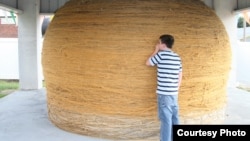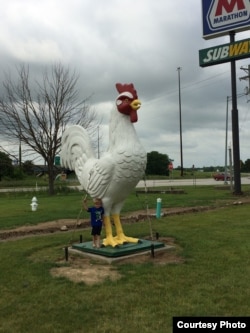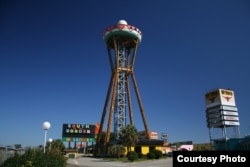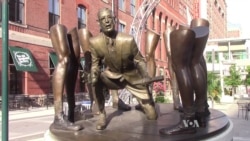The call of the open road, and the idea of the road trip have always been defining aspects of modern American life. Movies have been made, books have been written, lives have been led based on the idea that there is romance, danger and joy to be found on the concrete and asphalt lines that crisscross this sprawling country.
With the price of gas down considerably from last year, the American Automobile Association (AAA) says 56 percent of Americans plan to take at least one road trip this summer.
As they set out onto the open road, oftentimes tourists slow down and stop for a unique aspect of American life: the roadside attraction.
What are these oases of oddity?
There's no real definition, and categorizing them is at best a subjective art, but if it's free, extremely oversized, or just plain strange, chances are it qualifies.
No one knows exactly how many there are, because there is no mandatory registry, but June Julien, with the Steuben County, Indiana Visitor’s Bureau, says the website Roadside America, one of the few definitive sources on the subject, lists about 15,000 attractions.
One of the most famous, just below the North Carolina-South Carolina state line is "South of the Border."
This sprawling complex of hotels, restaurants, arcades and amusement park rides sits alongside I-95, one of the most crowded interstate highways in the United States.
It is impossible to miss because a giant sombrero rises above the pine trees, visible from miles away.
Then there are the giant dinosaurs that sit along the roadside in Cabazon, California, and the rows of buried Cadillacs in Texas.
The only thing they have in common is that they are easily accessible from the road. And most of them exist to get you out of the car for a while.
“Some of the reasons you’d stop at roadside attractions would be you’ve been in the car for hours, the children are antsy, the pets need some attention, you can get out, you can stretch your legs," Julien said. "You can have a little bonding time with your family on something and you’re looking at something that’s different, you don't see it every day.”
There are hundreds of roadside attractions in every state. Some are as subtle as the spot in the middle of a lonely dirt road where three states meet.
Once you brush the gravel from a small plaque, you can stand in Michigan, Indiana, and Ohio at the same time. Others, such as the Smiley Face water tower in Indiana, can be seen for miles. It’s part of a fraternity of more than 30 smiley water towers across the country.
A lure to stop and spend money
Roadside attractions gained popularity after World War II when U.S. soldiers returned home. The men had seen the world and were eager for more adventure and to explore their own country.
“As the highway system started to be developed, people started to travel. This was before the advent of fast food restaurants," Julien explained. "There just weren’t a lot of places to pull off. Areas started to say ‘hey, we want these people off the roads and we want them in our areas spending money,’ and they started to build things that would attract people.”
Restaurants and shops tried all sorts of gimmicks to lure travelers, everything from bright murals to crazy statues.
The "world’s largest" was always a big draw - the largest ball of twine, rocking chair, or tire.
If large was good for manufactured items, it was even better for natural things.
Kokomo, Indiana, is home to the World’s Largest Bull. Old Ben died in 1910, and is now stuffed and under glass. He weighed in at a whopping 2,140 kilograms and stood nearly two meters tall.
There are also just plain strange things, like shoe trees along the road in various states, which are festooned with sneakers and other footwear.
Indiana draws plenty of visitors as well. There's a twisted house in the shape of an arrow in Indianapolis and, if that’s not enough, there’s a self-guided tour of an outhouse collection in Huntington.
As strange as these roadside attractions are, Julien believes they may serve a purpose beyond giving travelers a break and bringing in revenue to nearby communities.
"Tourism can be the new peacemaker in our country," she says. "The more you travel, the wider your worldview is, and the easier in the long run for all of us to get along.”













